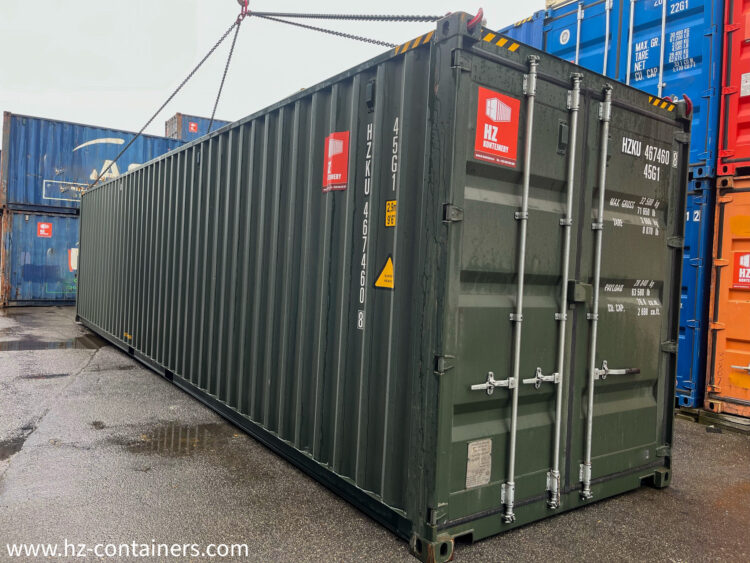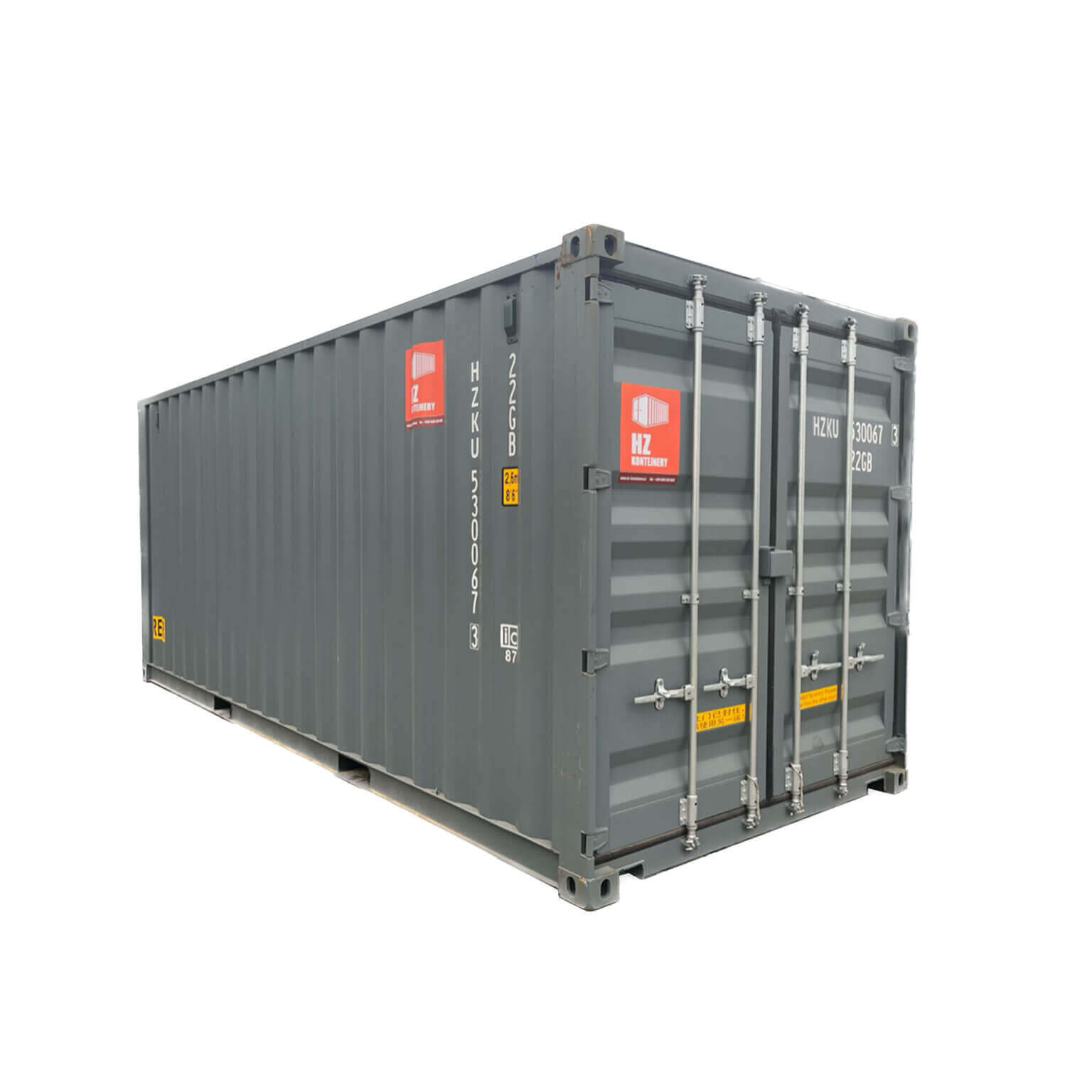SHIPPING CONTAINER 40
The 40-foot shipping container is the second most requested container for purchase. Known as the “Dry storage container 40 feet.” It is mainly used in cases where you need larger storage spaces. This type of container is very popular for its wide usage because you can easily convert it into storage space for a business. It can also be used for a house or garden to store garden items, or to create a larger garage from a shipping container. It can also be transformed into an original promotional booth or used for various storage purposes at different events.
The 40-foot shipping container is generally one of the most commonly used and widespread types of containers in the world of maritime transport and storage. This type of container is characterized by its robustness, versatility, and large capacity, making it ideal for various types of use. In this article, we will look at the specifications of this container, its quality, and various ways of utilization.

Quality of 40-foot shipping containers
The quality of shipping containers is a key factor for their long-term use and reliability. 40-foot containers are made from high-quality steel that is resistant to weather and corrosion. This material ensures that the container withstands extreme conditions during maritime transport, such as heavy waves, saltwater, and high temperatures. The containers are also equipped with sturdy doors that open and close easily, ensuring the secure closure of goods inside. Some models may have additional security features such as locks and seals, which further enhance their safety.
Use in transport and storage
40-foot shipping containers are ideal for a wide range of uses in transport and storage. They are most commonly used for transporting goods by sea, but they can also be utilized for rail and road transport. Due to their large capacity, they can hold a significant amount of goods, which increases efficiency and reduces transportation costs. Another significant use of these containers is in storage. Due to their robustness and durability, they are ideal for long-term storage of goods. Many businesses and individuals use shipping containers as storage units for various types of goods, from construction materials to personal belongings.
What is this container size suitable for?
40-foot containers are suitable for many different purposes. In maritime transport, they are often used to transport bulky goods such as cars, machinery, furniture, and electronics. Due to their large capacity and standardized dimensions, they are ideal for transporting goods in containers over long distances.
In storage, these containers are ideal for long-term storage of goods. Their robust construction and resistance to weather ensure that the goods remain safe and dry throughout the storage period. Many companies use these containers as temporary storage spaces at construction sites or as permanent storage units in industrial areas.
40-FOOT SHIPPING CONTAINERS FOR SALE – COMPLETE OFFER HERE
 | 40-FOOT SHIPPING CONTAINER – STORAGE CONTAINER | ||||||||||
| External dimensions (m) | Internal dimensions (m) | Door dimensions (m) | Weight kg | Volume | |||||||
| TYPE of container | length | width | height | length | width | height | width | height | container | max load | m3 |
| 40′ | 12.192 | 2.438 | 2.591 | 12.032 | 2.352 | 2.393 | 2.34 | 2.28 | 3610 | 28890 | 67.6 |
The external dimensions of the 40-foot shipping container are: length 12.192m / width 2.438m and height 2.591m with an allowable deviation of +-5 to 6mm
Internal dimensions: length 12.032m / width 2.352m / height 2.393m again with a possible deviation of +- 5 to 6mm
Door dimensions: width 2.393m / height 2.280m with a possible deviation of +-5mm
The maximum load for the 40-foot shipping container is: 67.6m3 / maximum allowable weight 28890 kg with a tolerance of 2% overload
The usable capacity of this container is 67.6 m³, providing ample space for transporting and storing a large amount of goods. Due to standardized dimensions, this container is easily maneuverable and compatible with most transport systems and storage equipment.
Our offer of 40-foot containers
In our offer, you will find all types of standard and specialized 40-foot shipping containers. We even specialize in customizing 40-foot shipping containers according to customer requirements.
We can offer you these 40-foot shipping containers available worldwide
- 40 feet: standard dry storage container with a length of 12.2 meters of classic width
- 40’ 2x doors: containers that have doors on both shorter sides of the container, suitable for simultaneous loading and unloading
- 40’ tarp roof: container designed for the transport of bulk and oversized materials, with a removable tarp roof
- 40’ width for 2 EUR pallets: large-capacity container custom-made for transporting goods on standard Euro pallets
- 40-foot side opening: containers with a side opening on the longer side, known as “side door,” mainly required for transporting large goods

What is the 40-foot shipping container made of?
Shipping containers have become an integral part of global goods transportation and play a key role in facilitating international trade. The most common types include 40-foot containers, which are used to transport a wide range of goods. To withstand the challenging conditions at sea and ensure cargo safety, they must be made from quality materials. Here is what 40-foot shipping containers are made of:
Steel structure
The main building material for 40-foot shipping containers is steel. The use of steel ensures high strength and resistance to mechanical damage. The steel structure of the container is designed to withstand high loads and resist challenging conditions such as strong waves, wind, and humidity. Corten steel, known for its high corrosion resistance, is most commonly used, which is essential for the long lifespan of the container in a marine environment.
Walls and roof
The walls and roof of a 40-foot container are also made of steel. The steel sheets are often corrugated, which increases their strength and impact resistance. This design also allows for better water drainage, which is important for protecting the cargo from moisture. The inner side of the walls is often coated with a protective layer that increases corrosion resistance and extends the container’s lifespan.
Floor
The floors of 40-foot containers are usually made of wooden boards firmly attached to the steel frame. The wood is treated with special chemicals to make it resistant to fungi, mold, and pests. Some modern containers may have floors made of composite materials, offering higher durability and longer lifespan. The floor must be strong enough to withstand high loads and impacts during loading and unloading of goods.
Doors and locking mechanisms
The doors of 40-foot containers are made of steel and equipped with robust locking mechanisms. These mechanisms include a sealing rubber that ensures waterproofing and protection against dust. The doors are designed to provide easy access to the cargo while ensuring its security. The locking mechanisms are crucial for protection against theft and unauthorized access to the cargo.
Surface finish
The entire container is coated with a protective paint that ensures corrosion resistance and extends the container’s lifespan. This paint is often applied in multiple layers to provide maximum protection. The surface finish also improves the aesthetic appearance of the container and allows for easy cleaning and maintenance.
Ventilation
40-foot containers are equipped with ventilation openings that ensure air circulation inside the container and minimize moisture condensation.
Certificates and standards
Each 40-foot container must meet international standards and certifications, such as ISO (International Organization for Standardization) and CSC (Convention for Safe Containers). These certifications ensure that the containers are manufactured according to strict technical specifications and are safe for transporting goods. Certified containers are regularly inspected to ensure their functionality and safety.

SPECIFICATIONS FOR 40′ SHIPPING CONTAINER
The shipping container is made of anti-corrosive steel: Corten A and is assembled from vertical corrugated steel sheets – so-called trapezoidal sheets. The floor is made of 28mm thick hardwood plywood. The floor is coated with a paint layer with a dry film thickness of at least 200 microns on a bitumen or wax base.
The container has double doors, each of which can rotate approximately 270 degrees. The doors are made of pressed horizontal corrugated steel sheets with a thickness of 3.0 mm for the top and bottom sections. The middle part of the doors is made of horizontal corrugated steel sheets with a thickness of 2.0 mm. The trapezoidal sheet metal side walls are made of steel panels with a thickness of 1.6 mm. Each door is mounted on four hinges with stainless steel pins. The doors have two sets of galvanized locking assemblies of the same model “SJ-66M” with steel handles and are mounted on each door using high-strength galvanized steel bolts.
Each container has two small plastic ventilation grilles. Each is attached to the upper right part of each side wall with three aluminum screws with a hinge diameter of 5.0 mm and sealed with sealant to prevent water leakage.
The container is painted with a zinc-rich primer. After drying, it is repainted with a high-strength epoxy top coat, such as RAL 3013. The dry film thickness of the top coat is 50 microns for the exterior and 40 microns for the interior, ensuring long life and corrosion resistance.
40-foot shipping containers are made from high-quality materials that ensure their strength and resistance to harsh sea conditions. The main construction material is steel, which forms the basic structure, walls, roof, and doors of the container. The floors are usually made from treated wood or composite materials. Surface treatments and protective coatings ensure corrosion resistance and extend the container’s lifespan.
Locking mechanisms, ventilation, and insulation materials are also essential components. All containers must meet international standards and certifications that ensure their safety and functionality.
In this article, we focused on the 40-foot shipping container (dry storage container 40 feet). We discussed its dimensions and capacity, container quality, their use in transport and storage, and the suitability of this container size. Key terms related to this topic include: 40-foot shipping container, dry storage container 40 feet, container dimensions, container quality, maritime transport, storage, container utilization.
If you want to dive deeper after learning about the 40′ shipping container, check out the specifications for the 40 HC. This article will give you insights into the high-cube version and its unique features. If you are considering smaller options, the specifications for the 20′ shipping container might interest you. It covers the details of this compact yet versatile container. For a broader understanding of storage solutions, explore the dry storage container page. It explains various uses and benefits, making it perfect for multiple applications. Lastly, if you're looking for something specific, the shipping container 20 HC could be worth a read. This page provides specifications for the high-cube version of the 20′ container.

